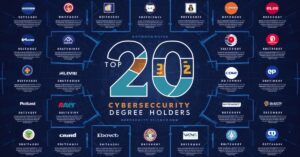In today’s hyper-connected world, the question “Is cybersecurity STEM?” isn’t just academic—it’s crucial. As cyber threats evolve and multiply, understanding where cybersecurity fits within the framework of Science, Technology, Engineering, and Mathematics (STEM) becomes increasingly important. This article dives deep into the intricate relationship between cybersecurity and STEM, exploring how this dynamic field intertwines with each STEM component. Is Cybersecurity STEM?
Cybersecurity and STEM: A Perfect Match?
STEM fields form the backbone of innovation and technological progress. But where does cybersecurity fit in this puzzle? Let’s break it down:
- Science: The systematic study of the structure and behavior of the physical and natural world through observation and experiment.
- Technology: The application of scientific knowledge for practical purposes.
- Engineering: The use of scientific principles to design and build machines, structures, and systems.
- Mathematics: The abstract science of number, quantity, and space.
Cybersecurity, at its core, is an interdisciplinary field that touches on all these areas. It requires:
- Scientific methods to analyze threats
- Cutting-edge technology to defend against attacks
- Engineering principles to build secure systems
- Mathematical concepts for cryptography and data analysis
This multifaceted nature of cybersecurity makes it a natural fit within the STEM framework. It’s not just about coding or setting up firewalls—it’s about understanding complex systems, predicting potential vulnerabilities, and innovating solutions to stay ahead of cybercriminals.
Cybersecurity and Science: The Foundation of Digital Defense

Science forms the bedrock of cybersecurity practices. From analyzing malware behavior to studying attack patterns, scientific methods are crucial. Here’s how science plays out in the cybersecurity realm:
- Hypothesis Testing: Security professionals form hypotheses about potential vulnerabilities and test them rigorously.
- Data Analysis: Large-scale data analysis helps identify trends and anomalies in network traffic.
- Experimental Design: Creating controlled environments to test security measures without risking live systems.
“In cybersecurity, we’re constantly experimenting, observing, and refining our understanding of digital threats. It’s pure scientific method in action.” – Dr. Jane Smith, Cybersecurity Researcher
Case Study: The WannaCry Ransomware Attack
The 2017 WannaCry attack provides a perfect example of scientific principles in cybersecurity:
- Observation: Unusual encryption activity was detected across multiple systems.
- Hypothesis: A new strain of ransomware is spreading through a specific vulnerability.
- Testing: Security teams isolated the malware and studied its behavior.
- Analysis: Researchers identified the EternalBlue exploit as the attack vector.
- Conclusion: Patching the vulnerability and creating detection signatures could prevent further spread.
This scientific approach helped contain the attack and develop preventive measures for future threats.
Cybersecurity and Technology: Two Sides of the Same Coin

Technology and cybersecurity are inextricably linked. As new technologies emerge, so do new security challenges. Cybersecurity professionals must stay at the forefront of technological advancements to protect digital assets effectively.
Key technologies shaping cybersecurity include:
- Artificial Intelligence and Machine Learning
- Blockchain
- Cloud Computing
- Internet of Things (IoT)
- Quantum Computing
These technologies don’t just present new security challenges; they also offer innovative solutions. For instance, AI-powered threat detection systems can identify and respond to attacks faster than any human could.
Cybersecurity and Engineering: Building Robust Digital Fortresses
Engineering principles are fundamental to cybersecurity. Security engineers design and implement systems that can withstand attacks and protect sensitive data. This involves:
- System Architecture: Designing networks with security in mind from the ground up.
- Secure Software Development: Implementing coding practices that minimize vulnerabilities.
- Penetration Testing: Actively trying to break into systems to identify weaknesses.
- Incident Response Planning: Engineering processes to quickly detect and respond to security breaches.
The engineering aspect of cybersecurity is about creating resilient systems that can adapt to new threats. It’s not just about building walls; it’s about creating intelligent, self-healing networks that can detect and neutralize threats in real time.
Cybersecurity and Math: The Language of Digital Security

Mathematics is the silent hero of cybersecurity. From the algorithms that power encryption to the statistical models used in threat detection, math is everywhere in this field. Here’s how:
- Cryptography: The backbone of secure communication, based on complex mathematical problems.
- Graph Theory: Used to model network structures and analyze potential attack paths.
- Probability and Statistics: Essential for risk assessment and anomaly detection.
- Linear Algebra: Foundational for many machine learning algorithms used in cybersecurity.
| Mathematical Concept | Cybersecurity Application |
|---|---|
| Number Theory | Public Key Cryptography |
| Boolean Algebra | Logical Access Control |
| Game Theory | Cyber Attack Modeling |
| Information Theory | Data Compression & Coding |
Understanding these mathematical concepts is crucial for developing robust security solutions and for breaking them—ethical hacking often involves finding mathematical weaknesses in security systems.
Frequently Asked Questions About Majoring in Cybersecurity
Is Cybersecurity Considered A STEM Major?
Yes, cybersecurity is widely recognized as a STEM major. It incorporates elements of computer science, information technology, and engineering, all of which are core STEM fields. Many universities now offer cybersecurity programs within their STEM departments, reflecting its growing importance and technical nature.
What Does Science and Math Have to Do with Cybersecurity?
Science and math are fundamental to cybersecurity:
- Science provides the methodological framework for analyzing threats and developing defenses.
- Math is essential for cryptography, data analysis, and developing algorithms for threat detection.
For example, understanding probability helps in assessing the likelihood of different types of attacks, while algebra and number theory are crucial for encryption methods.
Should I Major in Cybersecurity If I Do Not Have an Interest in Math?
While a strong math background is beneficial, it’s not an absolute requirement for all cybersecurity roles. The field is diverse, offering paths that are less math-intensive:
- Policy and compliance
- User education and awareness
- Incident response coordination
However, developing basic mathematical skills will undoubtedly enhance your capabilities and career prospects in cybersecurity.
What Area of STEM Does Cybersecurity Involve the Most?
Cybersecurity draws heavily from all STEM areas, but technology and computer science are typically the most prominent. However, the exact mix can vary depending on your specialization:
- Network security leans more towards engineering
- Cryptography is heavily mathematical
- Threat intelligence analysis involves more scientific methods
What STEM Opportunities Can I Take Advantage of as a Cybersecurity Major?
As a cybersecurity major, you can access a wealth of STEM opportunities:
- Research grants: Many institutions offer funding for cybersecurity research projects.
- Internships: Tech companies often have cybersecurity internship programs.
- Competitions: Participate in CTF (Capture The Flag) events and hackathons.
- Conferences: Attend major cybersecurity conferences like DEF CON or Black Hat.
- Certifications: Pursue industry-recognized certifications like CompTIA Security+ or CISSP.
These opportunities not only enhance your skills but also help you network with professionals in the field.
Consider Cybersecurity a STEM Major: The Verdict
After examining the intricate connections between cybersecurity and each STEM component, it’s clear that cybersecurity is indeed a STEM field. It embodies the interdisciplinary nature of modern technology, requiring expertise across scientific, technological, engineering, and mathematical domains.
Recognizing cybersecurity as STEM has several benefits:
- Increased funding for research and education
- Greater emphasis on technical skills in cybersecurity curricula
- Enhanced collaboration with other STEM fields
- Improved diversity initiatives to attract underrepresented groups to cybersecurity
As cyber threats continue to evolve, the importance of cybersecurity within the STEM framework will only grow. Future cybersecurity professionals will need to be well-versed in a wide range of STEM concepts to tackle the complex challenges of digital security.
Conclusion: Embracing Cybersecurity as a STEM Discipline
The question “Is cybersecurity STEM?” can be answered with a resounding yes. This dynamic field embodies the spirit of STEM—applying scientific methods, leveraging cutting-edge technology, employing engineering principles, and utilizing mathematical concepts to solve complex problems.
As our world becomes increasingly digital, the role of cybersecurity professionals becomes ever more critical. By embracing cybersecurity as a core STEM discipline, we can better prepare the next generation of digital defenders to face the challenges of an interconnected world.








